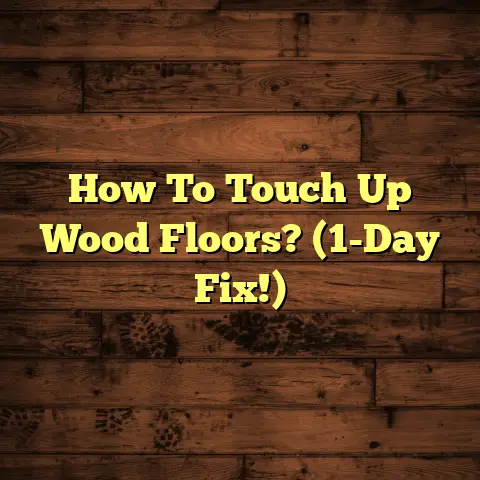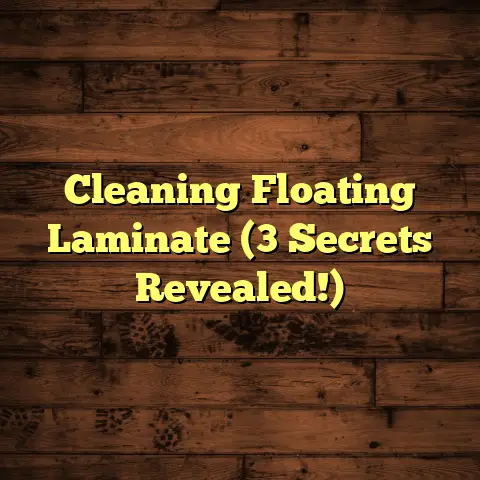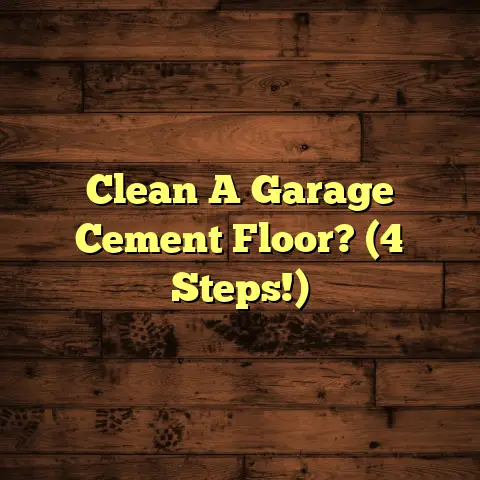Cleaning Cooking Oil Off Garage Floor (DIY Now!)
Imagine stepping into your garage.
The scent of fresh air mixes with the faint aroma of motor oil clinging to the walls.
It’s a space meant for creativity, a workshop where projects come to life, and everything has its place.
But today, as you glance down at the floor, your heart sinks.
A slick of cooking oil has spilled across the concrete, creating a hazardous slip-and-slide.
It not only threatens your safety but also mars the appearance of your beloved workspace.
The sun filters through the dusty windows, casting light on the glistening surface.
And you know that ignoring this mess is not an option. You can’t let this be the new normal.
It’s time to roll up your sleeves and tackle this greasy task head-on.
The good news is that cleaning cooking oil off your garage floor is a doable DIY project.
It will leave your space looking pristine and safe once again.
I’ve seen my fair share of garage floor disasters, and trust me, a cooking oil spill is a common one.
But don’t worry, I’m here to guide you through the entire process, step by step.
1. Understanding the Problem
So, what’s the big deal with cooking oil on your garage floor anyway?
Well, for starters, it’s slippery as all get-out!
According to the National Safety Council, falls are a leading cause of injury in the home, and a greasy garage floor is just asking for trouble.
Beyond the safety hazard, cooking oil can also damage your floor over time.
It seeps into porous surfaces like concrete, leading to stubborn stains and even weakening the material.
Now, let’s talk about the types of surfaces you might find in your garage.
Concrete is the most common, but you might also have an epoxy coating or even a sealed concrete floor.
- Concrete: This is the most porous option, meaning oil can really soak in.
- Epoxy: This creates a protective barrier, making cleanup easier.
- Sealed Concrete: Offers some protection, but still not as resistant as epoxy.
The type of surface you have will affect the cleaning process.
For example, epoxy is much easier to clean than raw concrete.
I have seen many oil spills on concrete floors, and I know how frustrating they can be.
I once had a client who accidentally knocked over a whole container of deep-frying oil in their garage.
The concrete absorbed the oil, creating a huge, dark stain.
It took a lot of elbow grease to get that one out!
2. Gathering Supplies
Alright, let’s get down to business.
Here’s what you’ll need to tackle that cooking oil spill:
- Absorbent Materials:
- Cat Litter: Cheap and effective for soaking up large amounts of oil.
- Baking Soda: Great for absorbing oil and neutralizing odors.
- Cornstarch: Another good absorbent option, especially for smaller spills.
- Cleaning Agents:
- Dish Soap: A degreasing dish soap like Dawn is your best friend for cutting through grease.
- Vinegar: A natural cleaner that can help break down oil.
- Commercial Degreaser: For tough stains, a commercial degreaser like Simple Green will do the trick.
- Tools:
- Scrubbing Brush: A stiff-bristled brush is essential for scrubbing the floor.
- Broom: For sweeping up absorbent materials.
- Mop: For rinsing the floor.
- Bucket: For holding water and cleaning solutions.
- Gloves: To protect your hands.
- Eye Protection: Safety glasses or goggles to keep cleaning solutions out of your eyes.
- Old Rags or Paper Towels: For wiping up excess oil and cleaning up spills.
You can find most of these supplies at your local grocery store, hardware store, or online.
Here’s a rough estimate of the costs:
| Item | Estimated Cost |
|---|---|
| Cat Litter | \$5-10 |
| Baking Soda | \$2-5 |
| Dish Soap | \$3-7 |
| Vinegar | \$2-4 |
| Scrubbing Brush | \$5-15 |
| Broom | \$10-20 |
| Mop | \$15-30 |
Note: Prices may vary depending on the brand and location.
As a pro, I’ve tested countless products over the years.
For a general oil spill, I usually reach for Dawn dish soap and a good scrubbing brush.
It’s a reliable combination that gets the job done without breaking the bank.
3. Pre-Cleaning Preparations
Before you start scrubbing, it’s important to prep the garage for cleaning.
Here’s what you need to do:
-
Clear the Area: Move any tools, equipment, or boxes away from the spill area.
You want to have plenty of room to work without tripping over anything. * Ensure Proper Ventilation: Open the garage door and windows to ventilate the area.
Some cleaning products can have strong fumes, so it’s important to have good airflow. * Wear Protective Gear: Put on your gloves and eye protection.
You don’t want to get cleaning solutions on your skin or in your eyes.
I can’t stress enough the importance of wearing gloves.
I’ve seen people skip this step and end up with irritated skin from the cleaning products.
Trust me, it’s not worth it!
4. Step-by-Step Cleaning Process
Alright, let’s get to the main event!
Here’s a step-by-step guide to cleaning that cooking oil off your garage floor:
4.1. Initial Absorption
- Cover the Spill: Generously cover the cooking oil spill with your absorbent material of choice (cat litter, baking soda, or cornstarch).
-
Let it Sit: Allow the absorbent material to sit for at least 30 minutes, or even longer for larger spills.
This will give it time to soak up as much oil as possible. * Sweep it Up: Use a broom to sweep up the absorbent material and dispose of it properly.
Don’t just toss it in the trash can, as the oil could leak out.
It is best to double bag the oil spill and dispose of it at the nearest disposal facility.
I usually let the absorbent material sit overnight for really bad spills.
The longer it sits, the more oil it will absorb.
4.2. Scrubbing
-
Mix Cleaning Solution: In a bucket, mix warm water with your chosen cleaning agent (dish soap, vinegar, or commercial degreaser).
Follow the instructions on the product label for the correct dilution ratio. * Apply Cleaning Solution: Pour the cleaning solution over the affected area. * Scrub Vigorously: Use a scrubbing brush to scrub the floor in a circular motion.
Apply plenty of pressure to loosen the oil from the surface. * Let it Sit (Optional): For stubborn stains, let the cleaning solution sit on the floor for 5-10 minutes before scrubbing again.
When scrubbing, I like to use a back-and-forth motion in addition to the circular motion.
This helps to get into all the nooks and crannies.
4.3. Rinsing
-
Rinse Thoroughly: Use a mop and clean water to rinse the floor thoroughly.
Make sure to remove all traces of the cleaning solution. * Dry the Floor: Use a clean mop or towels to dry the floor.
You can also let it air dry, but this may take longer.
Rinsing is crucial!
If you don’t rinse properly, the cleaning solution can leave a residue that attracts dirt and grime.
4.4. Final Touches
- Inspect for Stains: Once the floor is dry, inspect it for any remaining stains.
-
Repeat if Necessary: If you still see stains, repeat the cleaning process.
You may need to use a stronger cleaning agent or let the cleaning solution sit for a longer period of time. * Consider a Stain Remover: For really stubborn stains, you can try a commercial stain remover specifically designed for concrete or garage floors.
I’ve had success with using a pressure washer for really tough stains on concrete floors.
But be careful, as pressure washing can damage certain surfaces.
Always test it in an inconspicuous area first.
5. Preventive Measures for the Future
Now that your garage floor is sparkling clean, let’s talk about how to prevent future spills.
Here are a few tips:
- Use Mats or Trays: Place mats or trays under cooking appliances or containers of oil to catch any drips or spills.
- Regular Maintenance: Sweep your garage floor regularly to remove dirt and debris that can absorb oil.
- Inspect Regularly: Check for leaks or spills on a regular basis and clean them up immediately.
- Proper Storage: Store cooking oil and other liquids in sealed containers in a safe place where they won’t be easily knocked over.
-
Consider an Epoxy Coating: If you’re serious about protecting your garage floor, consider applying an epoxy coating.
Epoxy is a durable, stain-resistant surface that is easy to clean.
I always recommend epoxy coatings to my clients who want a low-maintenance garage floor.
It’s an investment that pays off in the long run.
According to a study by Grand View Research, the global epoxy coatings market is expected to reach \$43.77 billion by 2025. [Source: Grand View Research]
This shows the growing popularity of epoxy coatings for various applications, including garage floors.
6. Conclusion: The Satisfaction of a Job Well Done
And there you have it!
You’ve successfully cleaned that cooking oil spill off your garage floor.
Take a step back and admire your handiwork.
Your garage floor is now clean, safe, and ready for your next project.
Cleaning up a greasy mess like that can feel pretty satisfying, right?
You’ve not only improved the look of your garage but also created a safer environment for yourself and your family.
Remember, maintaining your workspace is an important part of being a responsible homeowner.
By taking pride in your DIY skills and keeping your garage clean and organized, you’ll create a space that you can enjoy for years to come.
So, keep up the good work, and don’t be afraid to tackle those DIY projects head-on.
You’ve got this!
And if you ever need any help with your flooring, you know who to call!





